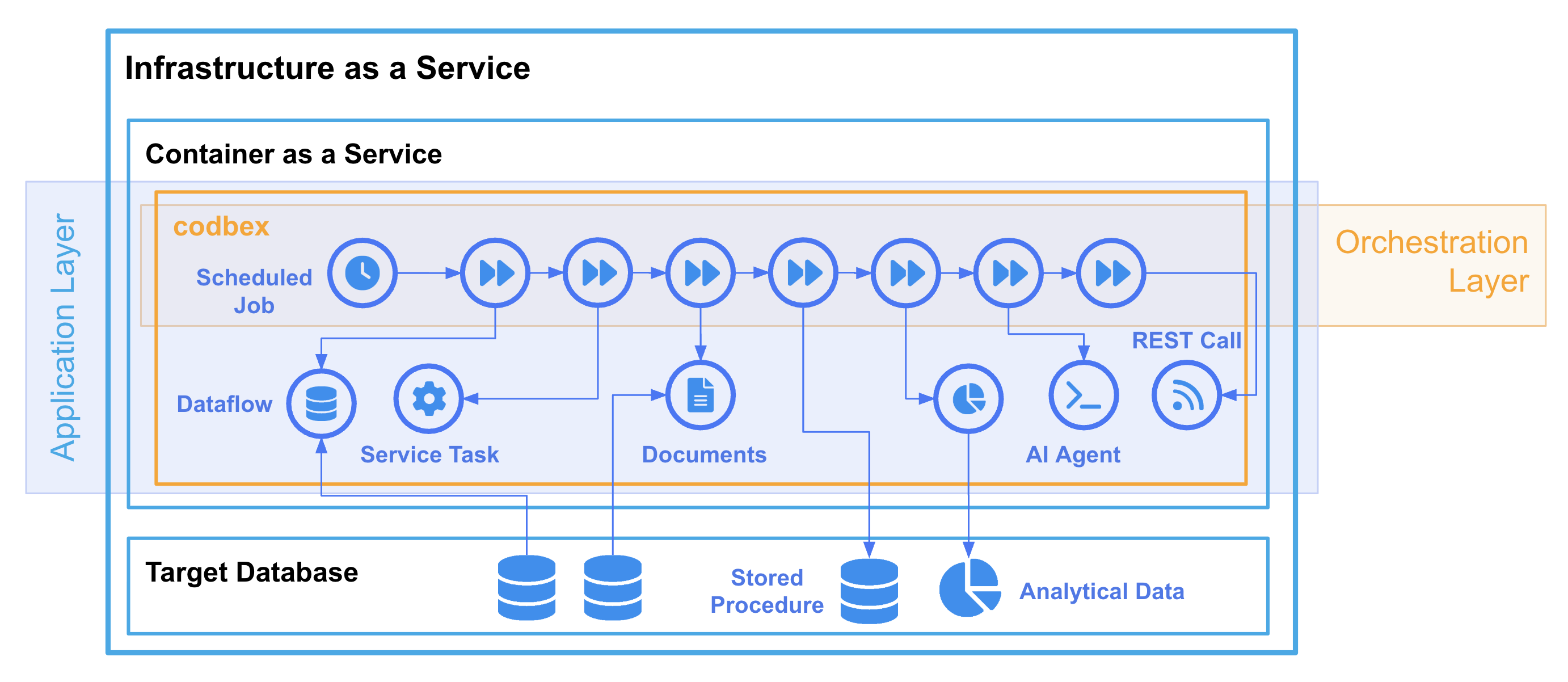Why Modern Architectures Need Orchestration
Chaos in the Cloud-Native World

Today’s cloud-native systems are often built on microservices and serverless paradigms, promising flexibility, scalability, and faster development cycles. These systems are inherently distributed, often running REST APIs, serverless functions like AWS Lambda, data pipelines via Apache Airflow, or integration flows using Apache Camel — all operating independently, often across multiple clouds.
However, as systems grow, managing how all these pieces interact becomes the real bottleneck:
- How do you coordinate dozens or hundreds of services?
- How do you monitor, govern, and recover from partial failures?
- How do you provide transparency to technical and non-technical stakeholders?
- How do you ensure auditability in regulated environments?
Without orchestration, what starts as agility turns into spaghetti logic, invisible dependencies, and escalating operational costs.
How Teams Try to Solve It?
Different teams use different tactics to solve orchestration challenges, often with mixed results:
1. Code-Based Orchestration
Using application logic to call other services — often through HTTP, message queues, or SDKs — embedded directly into microservices.
- ✅ Simple to start
- ❌ Hard to debug
- ❌ No transparency or reuse
- ❌ Tight coupling between services

2. Event-Driven Choreography
Services react to events in a loosely coupled way — often through systems like Kafka, SNS/SQS, or Pub/Sub.
- ✅ Decoupled and scalable
- ❌ Complex error handling
- ❌ Hard to trace workflows
- ❌ No central visibility
3. Task-Specific Workflow Tools
Using systems like Airflow, Step Functions, or Argo for individual use cases (data pipelines, job scheduling, etc.).
- ✅ Great for specific domains
- ❌ Poor at cross-domain coordination
- ❌ No unified governance layer
These approaches work — until they don’t. As complexity increases, teams need something more holistic.
Our Solution - BPMN-Based Process Orchestration for Everything
We offer a process management layer built on BPMN v2, tailored for the needs of modern, cloud-native and data-driven architectures. Think of it as the missing control plane for your microservices and serverless landscape.

Our platform allows you to define, orchestrate, monitor, and govern distributed tasks — regardless of what technology stack they use.
What You Can Orchestrate with Hyperion:
| Task Type | Supported Examples |
|---|---|
| REST API calls | External/internal microservices |
| Serverless functions | AWS Lambda, Azure Functions, Google Cloud Functions |
| Database procedures | Stored procedures in Snowflake, PostgreSQL, etc. |
| Integration flows | Apache Camel routes, SAP integrations |
| Data pipelines | Apache Airflow DAGs |
| ELT/ETL operations | Custom data flows in hybrid or multi-cloud |
All of these can be orchestrated as reusable process models, fully visible in a graphical designer and executable in our runtime.
What Makes It Different
- ✅ Open Standard: BPMN v2-compatible, no lock-in
- ✅ Decoupled Execution: Runs independently of the services it controls
- ✅ Governance & Compliance: Audit trails, checkpoints, versioning
- ✅ Monitoring & Transparency: See what’s running, where it failed, and why
- ✅ Composable Architecture: Easily plug in new systems or endpoints
Built-In Development Tools for Enterprise-Grade Delivery
The codbex platform includes a built-in browser-based IDE to support the full development lifecycle — from modeling to deployment.
Key Features:
- Integrated BPMN Designer: Visualize, design, and test your workflows
- Git Integration: Enterprise-grade version control with support for GitOps
- Centralized Development Workspace: One place for your processes, integrations, dataflows, connectors, and services
- Enterprise Readiness: Designed to meet the needs of regulated industries and large organizations with complex delivery pipelines
This makes it easy for developers, architects, and business analysts to collaborate, iterate, and ship faster, without compromising governance or quality.
Native Observability with OpenTelemetry
At runtime, the BPMN engine and all other execution components offer native OpenTelemetry integration.
- Seamless compatibility with cloud-native monitoring stacks (e.g., AWS CloudWatch, Azure Monitor, Google Cloud Operations)
- Unified tracing and metrics across distributed systems
- Alerting and logging hooks for real-time insight
This ensures end-to-end observability, making it easy to monitor, trace, and debug any process — no matter where it's running.
Real-World Architecture: From Backend to Data Stack

Our orchestration layer can be embedded into any cloud-native stack, and is especially powerful in:
- Microservices Governance: Centralize control over service flows, timeouts, retries, and human approvals
- Data Platform Orchestration: Combine Snowflake, and Airflow into unified data workflows
- Integration Hubs: Manage complex SAP, REST, and file-based integrations using Apache Camel as building blocks
We don’t replace your services — we coordinate them.
Available Where You Need It Most
- 🌐 Snowflake-native integration — enabling advanced orchestration inside data platforms
- 🇪🇺 Open Telekom Cloud — for EU-based deployments and digital sovereignty
- ☁️ All major public clouds — AWS, Azure, GCP, and hybrid scenarios
Whether you're building a sovereign cloud CaaS for your users, or coordinating cross-cloud data flows, codbex gives you full control with visibility.
Summary
Cloud-native systems thrive on modularity, but they fail without orchestration. codbex brings you a BPMN v2-compatible orchestration engine built for today’s serverless, microservices, and data-centric realities — enriched by:
- A full-featured browser IDE with Git integration
- OpenTelemetry-based monitoring and observability
- Cloud and data stack integration — from Snowflake to Open Telekom Cloud
Stop hardcoding orchestration into your services. Start managing your architecture — with governance, transparency, and scale.
Ready to take control?
Contact us to see our orchestration engine in action.